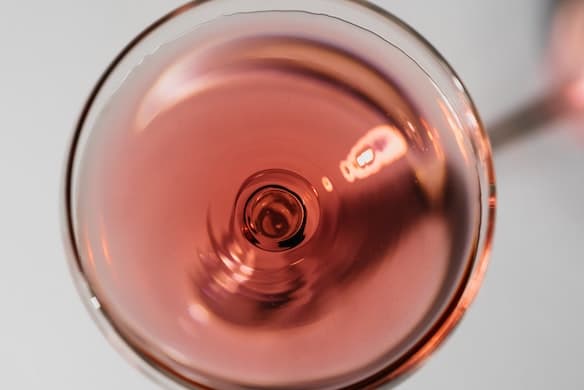Exploring Rosé’s Potential for Greatness
This week I tasted two of the very best, and they had a lot in common and some fascinating differences. It was Frank Corneliessen’s Susucaru Rosato 2021 versus Claus Preisinger’s Dope., also from the 2021 vintage.

Similar to my last column, we’ll now discuss another comparison of wines from two leaders of their class, only this time from a strikingly different category: Rosé.
Take what you know or expect of rosé and throw it out the window. This is not about sweet versus dry, or Provencal summer wine versus California White Zinfandel. Rosé has a reputation of being made as the lowest common denominator wine style. It is marketed as something fun, easy drinking, and non-pretentious.
For many consumers, good branding trumps taste when it comes to purchasing decisions. For winemakers, it can be a much needed cash infusion while they wait for their “good” wines to mature before bottling (meanwhile taking up space and not paying out for two-plus years after a vintage).
There have always been great examples of pink wine: Tempier, Tavel, and Domaines Ott, and the rare rosé from Champagne. Yet the potential for greatness has hardly been explored by any but a few intrepid winemakers. One group already set against the grain, and therefore may be giving a little more credence to the style as attention-worthy, is those from the natural side of things.
This week I tasted two of the very best. They have a lot in common and some fascinating differences. It was Frank Corneliessen’s Susucaru Rosato 2021 versus Claus Preisinger’s Dope., also from the 2021 vintage.
First up, Frank Corneliessen, a Belgian scientist by trade who turned to wine importing and then pivoted again to winemaking. He’s been a trailblazer of the natural wine movement. Not coming from a winemaking family or place, he’s beholden to no cultural or familial expectations. He purposely eschewed the traditional path of staging for established wineries in order to avoid their influence and the unlearning that goes along with it. Instead, he’s forged a path long and winding, making plenty of mistakes along the way toward his own truth in wine.
In 2001 he declared Sicily’s Mount Etna the best place in the world to make wine, moved there, and set up shop. Until the late 1980s this was a bulk wine zone and Mr. Corneliessen was one of the first to appreciate its value. Now it is recognized for its outstanding terroir, especially the volcanic soils and autochthonous variety Nerello Mascalese. Eruptions across millennia overlapped rock and ash in varying levels of decay for a patchwork of vineyards called Contrada, with nuances, differences, and site specificity reminiscent of those in Burgundy.
Mr. Corneliessen’s goal is to make “liquid rock,” or wines that taste exactly of their place (an active volcano). This starts with farming and a humble philosophy: “… acceptance of the fact that man will never be able to understand nature’s full complexity and interactions.” There are no certifications or dogmatic adherence to any one principle either in the vineyards or the cellar, just decisions based on trial and error.
Magma Rosso, his top wine, sells for more than $300, if you can find a bottle. Susucaru Rosato is its antithesis, a “lowly” rosé built for the masses, though nothing about it is ordinary — starting with its price; this year’s release was about $35.
There are a few different methods to make a rosé; this one is a blend of red and white grapes, which is illegal to do in France. Juice stays in contact with skins for 10 days, rather than the customary few hours of a “normal” bottle of rosé. The wine is really more akin to a very light red, but its transparent neon fuchsia glow in a clear glass bottle keeps it in the rosé category.
The wine itself possesses that je ne sais quoi found in all great wines: a fluidity, a sleekness, it’s alive, ever moving, filling all available space with its succulent, dense shape. Bone dry and salty, there’s a whiff of ash and a dark, gnarly minerality that overpowers the watermelon and strawberry juice profile. Compared to a typical Provencal style, this is rustic. Not tannic, but not non-tannic, it’s bursting with energy and flavor and texture, with a finish that just begs another sip. Rumor has it that this is Mr. Corneliessen’s favorite wine, and the inimitable character, exceptional quality, and pure drinkability certainly support this theory.
Claus Preisinger was born in Gols, a tiny village in the north of Burgenland, Austria. He is not so different from Mr. Corneliessen in that he also came to wine via his own volition, rather than inheriting a family legacy. They even started their own domains within a year of each other. Yet while Mr. Corneliessen’s path to wine was circuitous, Mr. Preisinger knew his calling at the tender age of 14.
I first met Claus Preisinger over a bottle of my other favorite rosé, Weninger’s Rózsa Petsovits, on a restaurant terrace on a muggy summer evening at Vienna. Immediately, his charm — a mix of intelligence, passion, and irreverence — won me over. As a surfer from a landlocked country, all of his interests are labors of love and take a forceful level of dedication. This comes through in all his wines.
Starting with nothing, he’s slowly bought up a collection of old-vine vineyards and built a strikingly modern winery. Farming is biodynamic, and no decision in the cellar is left unconsidered or unexamined.
Burgenland’s best assets are its mix of limestone and slate subsoil, and the exemplary, albeit nearly unknown, Blaufränkisch grape. Its terroir transparency is akin to that of Pinot Noir and is structurally sufficient to produce some of the world’s best underappreciated red wines. So why bother with rosé?
Because why not? Red gets all the attention, the best plots, the oldest vines, the nicest cellar treatment, and fetches the highest prices. If rosé was given the same resources, would it not be as noteworthy? The answer is yes, it can be, and Dope. is the proof.
Comparing Dope. to Susucaru is almost unfair, as its composition and intention was geared toward perfection, rather than quantity. Thirty-year-old Blaufränkisch from Goldberg, the best site on the Leithaberg in North Burgenland, were direct-pressed into amphora and aged for eight months before bottling.
The wine was thrillingly fresh, electric. It pops on the palate, helped by a touch of sparkle held over from fermentation, thanks to its crown cap. The limestone comes through in the tension of the acidity, taut like a highwire, while the texture of slate gives just enough angular expression to keep you from chugging it.
Beautiful, just-ripe blood orange and raspberry with fragrant, oily lemon and tangerine zest layered with Blaufränkisch’s most notable characteristic of Chinese five spice to carry it to a long dry finish. Like a savory dessert for dinner, drinking it was a joyous occasion.
The price of Dope. was the same as Susucaru, making it a bargain in my book. While the production was much smaller, because Claus Preising doesn’t have the same rabid followers as Frank Corneliessen, you may still be able to find a bottle if you are lucky.

